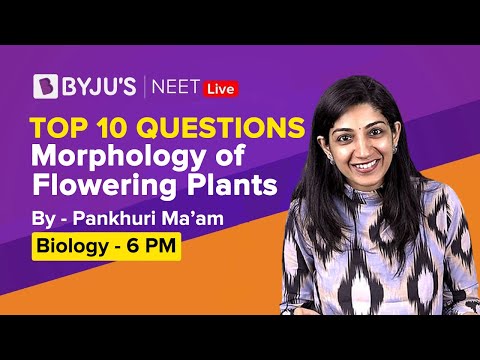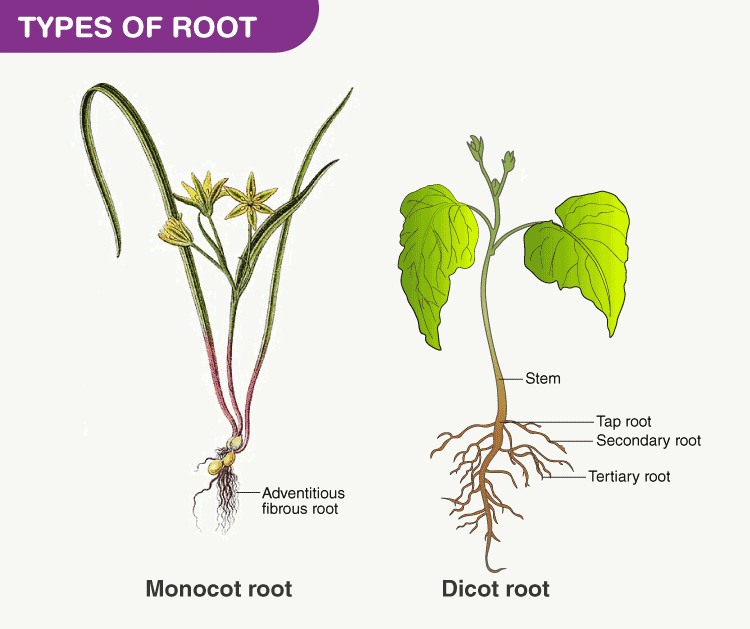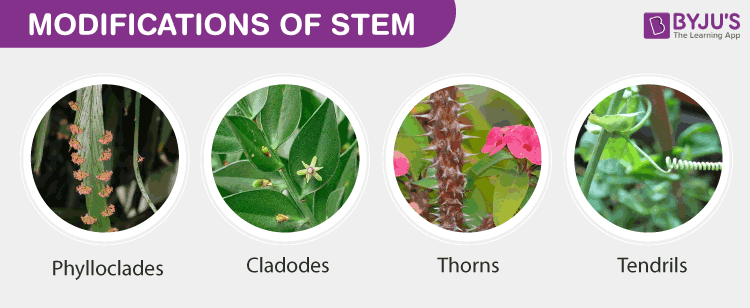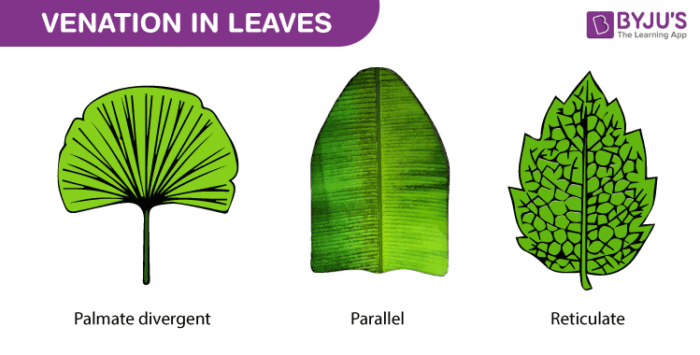Find below the important notes for the chapter, Morphology of Flowering Plants as per NEET Biology syllabus. This is helpful for aspirants of NEET and other exams during last-minute revision. Important notes for NEET Biology- Morphology of Flowering Plants covers all the important topics and concepts useful for the exam. Check BYJU’S for the full set of important notes and study material for NEET Biology and solve the NEET Biology MCQs to check your understanding of the subject.
Download Complete Chapter Notes of Morphology of Flowering Plants
Download Now
| Name of the NEET sub-section | Topic | Notes helpful for |
| Biology | Morphology of Flowering Plants | NEET exams |
Recommended Video:


Morphology of Flowering Plants – Important Points, Summary, Revision, Highlights
RootStemLeafInflorescenceFlowerFruitSeed
Morphology of Flowering Plants
The Root

- Tap root: Primary root is formed by elongation of the radicle and it bears secondary and tertiary roots, present in dicot plants, e.g. gram, mustard, etc.
- Fibrous root: found in monocotyledons. A large number of roots originate at the base of the stem, e.g. rice, wheat, etc.
- Adventitious root: Primary root is not formed from the radicle, e.g. grass, banyan tree, maize, etc.
Modification of the Root
- For storage: taproots- carrot, turnip; adventitious roots- sweet potato
- For support: Prop roots of Banyan tree, that arise from branches; stilt root of maize and sugarcane, that comes out of lower stem nodes
- For aeration: pneumatophores present in mangroves help them in respiration as it grows in swampy areas. These roots grow upwards above the ground, e.g. Rhizophora
- For nitrogen fixation: root nodules of leguminous plants
The Stem
- Plumule develops into stem
- The part of the stem which bears leaves is called a node and the part between two nodes is known as the internode
| Also check: NEET 2022 Answer Key |
Modification of the Stem

- Underground Stem: They help plants sustain unfavourable conditions for growth
- Rhizome- runs parallel to the ground and has nodes, internodes, buds, e.g. ginger, banana
- Tubers- the end part gets swollen as in potato
- Corm- it grows vertically below the ground, e.g. colocasia, etc.
- Bulb- stem is reduced and surrounded by scaly leaves, e.g. garlic, onions
- Stem Tendrils: these are a coiled structure that supports tender stem of the plant and help in climbing, e.g. grapes, cucumber, pumpkin
- Thorn: axillary bud gets modified into pointed thorns and protects plants from grazing animals, e.g. Bougainvillea, citrus
- Subaerial Weak Stem
- Offsets- internode of lateral branches decreases resulting in the rosette of leaves, e.g. Eichhornia, Pistia
- Suckers- lateral branches arise from the underground portion of the stem, e.g. chrysanthemum, banana, pineapple
- Runners- stem run horizontally above the ground and roots arise at nodes, e.g. grasses, strawberry
- Stolon- lateral branches arise normally but then bend down and touch the soil where the root grows and the new daughter plant arises, e.g. mint
- Aerial modification- The stem is completely metamorphosed for various adaptations, e.g. Phylloclade of xerophytic plants. The stem becomes fleshy and green having photosynthetic pigments to prepare food as leaves are reduced to thorns to check water loss by transpiration, e.g. Euphorbia, Opuntia
The Leaf

- Leaves originate from the apical meristem of a shoot
- Normally a leaf consists of three parts; leaf base, lamina and petiole
- Leaf base attaches to stem and may have two small leaf-like structures known as stipule
Types of venation:

- Reticulate- present in dicotyledons, there is a network of veins present, which are irregularly distributed
- Parallel- present in monocotyledons, veins are parallel to each other
Types of Leaves:
- Simple- lamina is complete and incision doesn’t reach midrib
- Compound- incision touches midrib, that divides a leaf into a number of leaflets
- Pinnately compound- the leaflets are present on the common axis, i.e. midrib, called the rachis, e.g. Neem
- Palmately compound- leaflets are attached at the petiole tip, e.g. silk cotton
Phyllotaxy: pattern of arrangement of leaves around the stem
- Alternate type- single leaf present at each node, e.g. Hibiscus, Brassica
- Opposite type- each node bears a pair of leaves, e.g. Psidium guajava, Calotropis
- Whorled type- more than two leaves arise at the node to form a whorl, e.g. Alstonia
Modification of Leaves
- Tendrils- leaves modified to form a long thread-like structure, it gives support to climbers, e.g. peas
- Spine- in xerophytic plants to reduce water loss, e.g. cactus, aloe
- For storage- e.g. garlic, onion
- Phyllodes- petiole gets modified to form a leaf-like structure and function, e.g. Acacia
- Pitcher in pitcher plant is a modified leaf which traps insects inside
Inflorescence

- The arrangement of the flowers around the floral axis
- The two main types of inflorescence are
- Racemose: the main axis grows indefinitely, flowers are present laterally in acropetal succession i.e. older flowers at the bottom and the younger ones at the top. Types of racemose inflorescence: raceme, spike, umbel, capitulum, corymb, catkin, spadix, etc.
- Cymose: the main axis terminates in flower and has limited growth. Flowers are borne in a basipetal order i.e. older flowers are at the top and new flowers are at the bottom. Types of cymose inflorescence: monochasial cyme, dichasial cyme, etc.
- Special types of Inflorescence
- Verticillaster: sessile flowers arranged in dichasial cyme, e.g. Ocimum, Salvia
- Cyathium: involucre of bracts form cup shape structure, single female flower is surrounded by numerous male flowers, e.g. Euphorbia
- Hypenthodium: both male and female flowers are present in a cavity with an apical opening called ostiole, e.g. Fig
The Flower
- A flower has four whorls; calyx, corolla, androecium and gynoecium. These are attached to the swollen terminal of pedicel called the thalamus
- Flower symmetry:
- Actinomorphic- radially symmetrical flowers, e.g. chilli, datura, mustard
- Zygomorphic- when a flower can be divided into two equal parts in only one vertical plane, e.g. Cassia, pea, etc.
- Flowers can be trimerous, tetramerous or pentamerous depending on the multiple of floral appendages present 3, 4 or 5
- Types of flowers depending on the presence or absence of bracts (reduced leaf present at the base of pedicel); Bracteate or Ebracteate
- Types of flowers based on the position of the ovary:
- Hypogynous- gynoecium occupies the highest place, above all the other parts. The ovary is known as superior, e.g. brinjal, china rose, mustard
- Perigynous- gynoecium is present at the same level as the rest of the parts of a flower. The ovary is known as half inferior, e.g. peach, plum, rose
- Epigynous- thalamus encloses the ovary completely and other parts are present above it. The ovary is known as inferior, e.g. ray florets of a sunflower, guava, cucumber
Parts of a Flower

Calyx: A flower’s outermost whorl is made up of leaf-like structures called sepals
Gamosepalous- sepals united
Polysepalous- sepals free
Corolla: made up of bright coloured petals. Present after sepals
Gamopetalous- petals united
Polypetalous- petals free
Aestivation:

It is the mode of arrangement of sepals and petals. The main types of aestivations are:
- Valvate- sepals or petals just touch each other and don’t overlap in a whorl, e.g. Calotropis
- Twisted- sepal or petal overlaps the next sepal or petal and the same continues in a whorl, e.g. cotton, china rose, lady’s finger
- Imbricate- margins of sepal and petals overlap each other randomly and not in one direction, e.g. Gulmohar, Cassia
- Vexillary- the largest petal overlaps two petals (wings) present laterally on both the sides and that overlaps the two anterior petals (keel) in the same way. It is also called papilionaceous, e.g. beans, peas
Androecium: It is a male reproductive part. It consists of stamens. Each stamen is made up of filament and anthers.
- Staminode- sterile stamen
- Epipetalous- stamens are attached to petals
- Polyandrous- stamens are free
- Monadelphous- stamens are united and present as one bundle
- Diadelphous- stamens are united and present in two bundles
- Polyadelphous- stamens are united and present in more than two bundles
Gynoecium: It is a female reproductive part. It consists of carpels. Each carpel has three parts; stigma, style and ovary.
- Apocarpous: more than one carpels present, which are free, e.g. rose, lotus
- Syncarpous: more than one carpels present, which are united, e.g. tomato, mustard
Placentation:

The specific arrangement of ovules in the ovary is called placentation. Types of placentation:
- Marginal- e.g. pea
- Axile- e.g. lemon, china rose
- Parietal- e.g. Argemone, mustard
- Free central- e.g. Primrose, Dianthus
- Basal- e.g. marigold, sunflower
The Fruit
It is a matured and ripened ovary after fertilisation.
- Parthenocarpic fruit: the fruit formed without fertilisation, it makes seedless fruits, e.g. pineapple
- Seed and pericarp make a fruit. The fleshy pericarp is made up of three layers; epicarp, mesocarp and endocarp
The Seed
After the fertilisation, the ovule develops into a seed.
- A seed has a seed coat and an embryo. An embryo is made up of radicle, embryonal axis and one or two cotyledons in monocotyledons (maize, wheat) and dicotyledons (pea, gram) respectively.
| Dicotyledonous seed | Monocotyledonous seed |
| The seed coat is made up of two layers; outer testa and inner tegmen
There is a scar present through which the seed was attached to the fruit while developing, it is called the hilum The micropyle is a pore above the hilum |
The seed coat is fused to the fruit wall and membranous |
| The embryo consists of an embryonal axis and two cotyledons | The embryo consists of one large cotyledon known as scutellum |
| Cotyledons store food | The endosperm is bulky and stores food |
| Mostly non-endospermic seeds.
In castor, an endospermic seed is present- endosperm is formed due to double fertilisation and stores food |
Mostly endospermic seeds.
Some seeds like orchids are non-endospermic. Aleuron (a proteinaceous layer), is the outermost layer of endosperm, which separates the embryo |
| Radicle and plumule are present at the two ends of the embryonal axis | Plumule is enclosed in coleoptile and radicle is enclosed in coleorhiza |
Explore the next chapter for important points with regards to the NEET exam, only at BYJU’S. Check the NEET Study Material for all the important concepts and related topics.
Also see:
NEET Flashcards: Plant Kingdom
NEET Flashcards: Morphology Of Flowering Plants
NEET Flashcards: Anatomy Of Flowering Plants
I need notes for exam
Please check these links for notes – https://byjus.com/cbse-notes/ and https://byjus.com/cbse-notes/cbse-revision-notes/